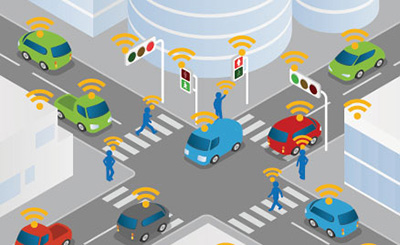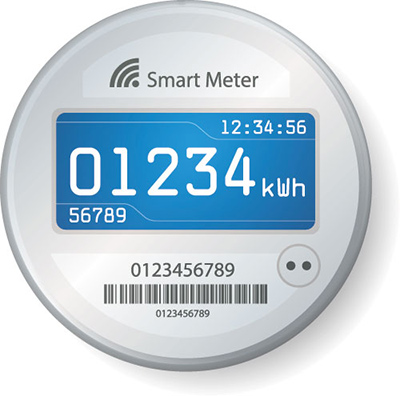Infrastructure has always been important to our nation’s economic growth and social progress, but the infrastructure needed for today’s economy is rapidly changing with advances in information technology (IT). Infrastructure that integrates both physical and digital components will be critical to delivering the next wave of social and economic change.
Some would argue that little innovation is possible in infrastructure because—just like 50 or even 100 years ago—cars still drive on roads, planes fly in the air, and trains run on tracks. But while we are nowhere near flying cars or hyperloop trains, we are in an era where IT is being embedded into physical devices and structures—what is now being called hybrid digital infrastructure. For example, water mains embedded with sensors to detect and transmit information on leaks become digital infrastructure. Traffic lights with the ability to sense vehicles in real time and change signals are digital infrastructure. An electric grid that uses smart meters, advanced control systems, and communication networks to gather, distribute, and respond to information is digital infrastructure.
To propel the nationwide transformation to smart infrastructure, these are steps the next president should take:

Digital infrastructure includes features such as traffic lights with the ability to sense vehicles in real time and change signals.
Transforming traditional infrastructure into hybrid digital infrastructure will provide four major benefits.
Digital infrastructure will allow infrastructure providers to more easily bring market forces to bear. Historically, markets only work effectively when there are accurate price signals and low transaction costs. Smart infrastructure enables the easy collection and analysis of data so that services can be more easily and accurately priced, ensuring that supply and demand are more closely and dynamically aligned. For example, pricing road use would significantly increase travel efficiency. This is because drivers impose costs on others or on the system, and current road infrastructure systems do a poor job of charging users for these costs. If drivers have to pay more to drive on a crowded freeway at rush hour, congestion will go down as people choose other modes or times to travel.
Digital technologies will allow infrastructure to be used more efficiently. Smart traffic lights would improve traffic flow because cars would spend less time stuck at red lights. Embedding sensors in water systems would reduce leaks and losses. And the NextGen air traffic control system—a satellite-based aviation tracking system being developed by the FAA—will enable more “as the crow flies” shorter routes for airplanes.
The New Jersey Turnpike Authority partnered with IBM to place sensors and cameras on the turnpike to analyze data and reduce congestion.
Data generated by digital infrastructure allow providers to gain more accurate and timely insights about performance. Sensors embedded in transportation infrastructure can provide city managers and urban planners with valuable information about how well the infrastructure is meeting the needs of travelers and can also power analytical models that can ensure infrastructure-planning decisions are as effective as possible. For example, the New Jersey Turnpike Authority has partnered with IBM to implement a traffic management program that analyzes data generated by more than 3,000 sensors and cameras on the New Jersey Turnpike and Garden State Parkway to reduce congestion.
Digital infrastructure makes it possible to gain insight into real-time conditions. One way providers traditionally find out about conditions is when the infrastructure fails. Applying a digital layer to infrastructure allows for real-time insight into performance, which can generate substantial economic and public safety benefits through preventive maintenance and early warning systems. For example, by embedding connected sensors in a bridge, civil engineers can monitor structural changes in real time and perform preventive maintenance before a defect threatens the structural integrity of the bridge.

One of the challenges for digital infrastructure is how to encourage more implementation—as more houses have smart meters, more appliances will be smart.
Despite the benefits offered by digital infrastructure, the introduction of these new technologies has been slow because the organizations involved in the transition have been reluctant to change. The challenge is that the people who fund, build, and maintain America’s infrastructure, especially in government, have been slow to embrace the digital revolution, preferring to invest in tried-and-true “concrete” rather than unknown and risky “chips.” There are number of reasons for this halting transition.
As with any new technology, there are risks, especially for governments that own or operate infrastructure. Infrastructure operators, particularly government officials, lack experience with digital technology. There is a lack of patient, up-front capital available for digital innovations even if they will more than pay for themselves over the life of the project.
Many digital technologies involve a whole set of coordination challenges. Smart grid technology, for instance, must be interoperable across utility grids, not just within one. The same is true for smart city/smart transportation technology. Moreover, there are chicken-or-egg issues involved. As more homes have smart meters, more appliances will be smart and able to utilize signals from smart meters. But since there are few smart meters, there are few smart appliances, and vice versa.
Many infrastructure organizations have been slow to take up digital technology because of pressure from privacy advocates who intentionally present frightening, but false, scenarios of how this technology will infringe on privacy.

The next president should convene a digital infrastructure council that meets regularly to plan the best ways to use digital technologies, such as data analytics and artificial intelligence, to improve infrastructure.
Finally, the proliferation of thousands of government and regulatory bodies makes it difficult to adopt common standards for technology and regulations.
Because of the significant benefits offered by digital technology, it is likely that all infrastructure will become digital at some point in the future. But without proactive public policies, this transition may take a very long time. For this reason, the next administration has a unique opportunity to accelerate the transition from traditional infrastructure to hybrid digital infrastructure.
The next administration can start by having the president establish a digital infrastructure council, made up of key officials from federal agencies involved in infrastructure, including the departments of housing and urban development, transportation, defense, energy, interior, the Environmental Protection Agency, and the Federal Energy Regulatory Commission. These officials should meet regularly to discuss how their agencies plan to use digital technologies—such as the Internet of Things, data analytics, and artificial intelligence—to improve infrastructures they control, including the power grid, water systems, and roads. In addition, the president should charge each agency to develop within six months strategies for advancing the transition to digital infrastructure in the areas they influence. For example, the Department of Transportation should lay out a strategy for promoting the rapid deployment and adoption of proven intelligent transportation systems. The Department of Defense should offer a strategy for how it can use IT to modernize infrastructure at defense installations across the nation. The Environmental Protection Agency should focus on making water and waste systems intelligent. To implement these strategic plans, the president should ensure that the first budget sent to Congress includes significant funding for the transition to digital infrastructure.

The Obama administration established the Smart Cities Challenge grant program, which awarded $40 million to Columbus, Ohio, to advance infrastructure innovation.
Because much of infrastructure is funded and operated at the state and local level, advancing infrastructure innovation will require states and cities to experiment in order to “de-risk” these new technologies. The Obama administration took several steps in this direction, for example with its Smart Cities Challenge Grant program, which awarded $40 million to the winner, Columbus, Ohio. The next administration should build on this initiative, announcing two new competitions, one for smart cities and one for states, for intelligent transportation systems. The first would provide funding for at least three new cities, one large, one midsized, and one smaller and rural. The second would fund a competition to determine which state can do the most to implement an intelligent transportation system. Both competitions should be designed to fund the development and deployment of systems that can be scaled nationally after they are proven at the local and state levels.
Further, the next administration should work to promote digital applications that can be used across the nation. A number of cities and states have already introduced novel apps that improve the performance of transportation networks, enhance their safety, and streamline infrastructure repairs. Boston, for instance, created Street Bump, a smartphone app that identifies potholes when cars drive over them and then automatically (and anonymously) relays the locations of the potholes to the city’s transportation department. The San Francisco Municipal Transportation Agency developed SFpark, a parking management system deployed at 7,000 of the city’s 28,800 metered spaces and 12,250 spaces in 15 of 20 city-owned parking garages. The app tracks open parking spots and sets prices dynamically according to availability and demand.

Urban planners and researchers need more data about how pedestrians move across a city so they can better plan for their mobility and safety.
These exciting digital innovations will need help from the federal government if they are going to be used nationwide. For example, any city could use Street Bump if the app were cloud-hosted and had a geocoded algorithm to send pothole data to the relevant municipality. But a collective action problem arises, as individual cities have no particular interest in scaling their own innovative applications for the benefit of other cities. To address this, the next president should charge the Department of Transportation with coordinating the development of national IT systems and cloud storage that could be used by all state and local governments.
Likewise, the Department of Housing and Urban Development should take the lead in organizing a national system to gather urban data. For example, planners and urban researchers need data on how pedestrians move across a city. One could imagine an app that collects this movement anonymously and on an opt-in basis and then, based on the geocode, aggregates the pedestrian trip data for local governments. Likewise, HUD could support standards that allow all city zoning maps to be digitized and put on an easy-to-use app. Similarly, the White House should sponsor a competition to identify the 20 best such applications and then ask a nonprofit, such as Code for America, to take applications initially developed for individual cities and code them for use on a national basis.
Finally, the next president should take action to spur transportation infrastructure innovation. In 2012, the United States launched the National Network for Manufacturing Innovation (now named Manufacturing USA). This network brings together industry, universities, community colleges, and government agencies at all levels to support precompetitive R&D to accelerate innovation in the manufacturing sector. The next administration should establish two new institutes led by the Department of Transportation. The first institute should bring together industry, government, and university partners to pursue the R&D necessary for advancing high-impact intelligent transportation systems and autonomous vehicles so that these lifesaving technologies reach America’s roadways faster. A second institute should investigate new materials for surface transportation. States annually spend $16.5 billion to repair existing roadways, but these costs could be reduced through the use of innovative surface transportation technologies such as flexible or modular concrete. Likewise, concrete embedded with smart sensors can monitor stresses on bridges or road conditions (i.e., icy and slippery) that could considerably enhance bridge safety. Improvements in the materials used to build the physical infrastructure could play a significant role in boosting durability and lowering maintenance costs.
Information technology is creating a smart world—from smart enterprises to smart schools to smart cities. The next president has a unique opportunity to accelerate the transformation of our existing physical infrastructure to a smart hybrid infrastructure. To be sure, it’s not as exciting as committing to land a man on the moon by the end of the decade, as John Kennedy proposed, but embracing a commitment to make America’s infrastructure smart by 2027 would go a long way toward restoring America’s “can do” attitude.